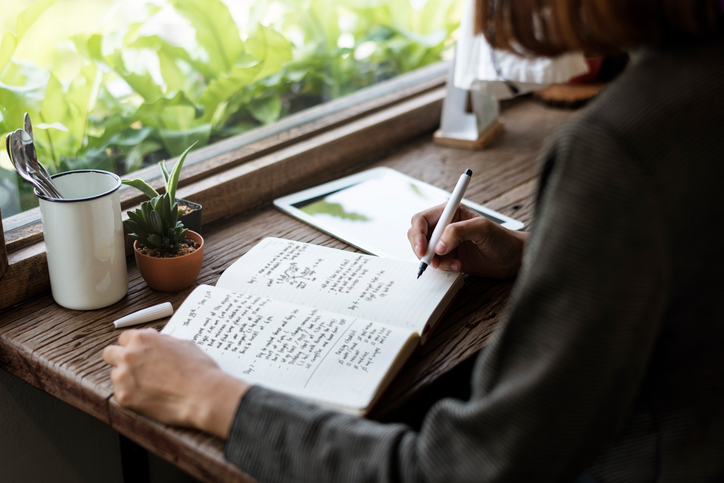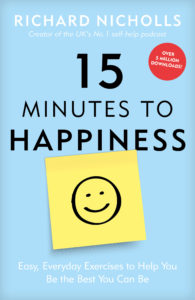Psychotherapist Richard Nicholls has written recent book called 15 minutes to happiness so he is well-placed to deliver this advice on how to be happier
Life can be overwhelming and in a 21st century society that often promotes a fake and filtered Instagram world in which it can be hard to override the urge to compare ourselves to others despite the fact that we’re fully aware that it knocks our self-esteem.
Even though all the self-help books tell us not to value material goods over our relationships and experiences we still feel the pull towards the next shiny object. So are there ways of getting stronger? What does science tell us are the best ways of boosting our willpower so that we can feel more in control and happier?
Well, I’m glad you asked.
I’ve been working as a therapist since 2001 and have been absorbing decades of research that help to identify what does and what doesn’t work when it comes to improving our happiness. Here’s what definitely does
How to be happier rule #1: Journal
Keeping a personal journal is a great way of helping to gain a better perspective on things. Research has even shown it to have the same benefits as a counselling session does. Writing about your experiences and your emotions helps the brain to see your problems as external to you. It keeps the past in the past and means that a future that hasn’t even happened yet doesn’t seem so scary.
How to do it: Writing a journal isn’t about wallowing in self-pity. It’s a tool to help you see alternative ways of thinking, feeling and behaving. A way of looking back over what you’ve written so you can see the changes in your attitude over time. So grab a notepad and a pen and get writing. The grammar and spelling can be all over the place and it doesn’t need to be creative.
Journaling is way of looking back over what you’ve written so you can see the changes in your attitude over time
If you’re going to write about something that happened that day which made you unhappy, also write about the thoughts you had that allowed the unhappy feeling. Write about how you’d prefer to think and feel if it were to happen again.
You can’t beat using a simple notebook to do this because it allows you to dump everything that’s in your head without being able to edit it afterwards.
The whole idea of this process is to give you a space to let your thoughts flow, and knowing that you can change it to make it perfect isn’t helpful. Which is maybe why using an electronic device doesn’t seem to have quite the same effect. Sure, it’s more private and if that’s important to you then it might be better to use an App or set up a new Gmail address, to email your thoughts to. Knowing that no-one will be able to log into it to read them. You can periodically log in yourself to read through past messages, gain insight and hopefully see how far you’ve come.
How to be happier rule #2: Mindfulness Meditation
Mindfulness is a simplified form of meditation that helps to improve our ability to bring things into the present, and has some very beneficial effects upon the brain and body. Research has shown that adding mindfulness into your life has a positive effect upon the regions of the brain related to attention and sensory processing with the potential to even offset the effects brought on by the ageing process and Alzheimer’s disease.
How to do it: The origins of mindfulness go back thousands of years and are rooted in Buddhist meditation exercises as a path to spiritual enlightenment. This is done by sitting quietly, moving the focus of your attention away from the outside world, away from the past, away from the future and into the present moment. It involves separating thoughts from awareness, such as being aware of the cushion you’re sitting on but not thinking about it.
It’s about being aware that your mind wanders and learning how to better react to it.
Put simply, mindfulness is about learning to relax and be at peace with your thoughts. It can take a little time to become good at it, but it is well worth putting the effort in. People often make the mistake of thinking that they can’t do it because their mind always wanders whenever they try to relax, but that’s the whole point of mindfulness. It’s about being aware that your mind wanders and learning how to better react to it.
Someone with 10 years’ practice can maybe sit for 15 minutes and meditate without their mind wandering at all, but at first you might only be able to manage five seconds. That’s fine. In 15 minutes of mindful meditation, you might only be doing it properly for five seconds at a time every five minutes, and the rest of the time your mind is busy thinking about all the jobs you should be doing. That’s fine. Keep at it and it soon becomes ten seconds every 5 minutes, then 20 seconds every 4 minutes. Maybe it will take months of daily practice before you can do it for a minute at a time and with only 30 seconds of mind wandering in-between. That’s fine. Your brain is getting more efficient every day that goes by, dealing with stressful situations gets easier, making decisions becomes effortless and your faith in yourself becomes stronger.
You can find endless free resources around the internet to experiment with and within a few months, you’ll find that even when you’re not meditating, the mindful attitude will be with you everywhere you go. Gratitude becomes second-nature to you as you find it easier to appreciate everything. You’ll become happier.
How to be happier rule #3: Emotional Control
Whether we’re experiencing emotion because we have a job interview the next day or because our dog has just died our brain will interact with our body in the exact same way to create some sensations, this is why we often call our emotions ‘feelings’. This emotional response is often called “The Fight Or Flight Response”. It’s a reaction within the body that prioritises sending oxygen to the muscles so that should we need to run from a sabre toothed tiger we have the energy in our muscles to do so.
This is why we may feel ‘butterflies’ when we’re nervous – the blood is being pulled out of the gut to get as much oxygen into the muscles as possible. This causes two things to happen, to make up for the fact that there is never normally enough oxygen circulating in the blood to fuel the muscles in a crisis. Firstly, adrenaline is released to speed up the heart and direct what little oxygen is in the blood around the body as fast as possible, and secondly, breathing speeds up to try and get even more oxygen in. Depending on our personality type, the situation or our habits, these feelings can make us feel any one of many emotions – anger, impatience, grief, anxiety, plain old boredom or whatever else.
one of the best ways of learning how to control our emotions is to learn how to breathe efficiently.
How to do it: One of the best ways of learning how to control our emotions is to learn how to breathe efficiently. The mistake that people tend to make is that when they breathe in they pull their stomach in and puff their chest out to try and expand their lungs. But the ribcage is in the way and so the lungs can’t expand giving the impression that the lungs are full, but actually are probably still half empty.
A more efficient way of breathing for emotional control is called “Diaphragmatic Breathing.” To do this place one hand on your chest and the other on your stomach. Allow your shoulders to relax and push your stomach out slightly as you breathe in for the count of three. Ensure that the hand that’s on your chest doesn’t really move that much, it’s the hand on your stomach that pushes out as you inhale. Hold your breath and count to 3 again. Then breathe out slowly for the count of 6. If you do this 2 or 3 times you will find that emotions don’t get the better of you and you feel much more in control.
How to be happier rule #4: Thought Control
Our brain doesn’t really understand the difference between fact and fiction. Which is why someone talking about head lice or creepy crawlies can make us itch even though we know there’s nothing touching us. We can use this to our advantage by spending time thinking about the steps we need to take to reach our goals, but it can also work against us if we spend time thinking of all the things we fear. Unfortunately, fearful outcomes capture more of our attention than the things we want to embrace in life and so it can be quite hard to move our thoughts from something negative to something positive.
How to do it: To do this it’s a good idea to practise a technique called ‘Thought Stopping’ by putting an extra thought in the middle of the negative and positive thoughts to help capture your attention and control your thoughts. To do this, as soon as you notice that you’re obsessing over a thought, you need to shout, as loud as you can in your head, the word STOP! You can shout it as many times as you like or just the once. But if it’s just the once, let it ring out in your mind for 3 or 4 seconds at least. STOOOOOOOOP! At the same time, also picture something that represents the word STOP, a traffic light, a road sign, a penguin holding up a placard. It doesn’t really matter what it is – you’re learning to control your thoughts, and anything that can capture your attention will work fine, no matter how odd the image is.
We can use this to our advantage by spending time thinking about the steps we need to take to reach our goals
Once you’ve moved your focus of attention away from the negative thought, you’ll have more control over where it goes next. Think about the exact opposite to the native thought. If there isn’t one then distract yourself with any thought at all, sing 3 Blind Mice or 10 Green Bottles. Try remembering the theme tune to Fraggle Rock or The Fresh Prince of Bel-Air. Whatever you do with your thoughts, as long is it’s more appropriate than what you were doing with it before, it’s going to be a good distraction.
How to be Happier rule #5: Put Yourself First
Is putting yourself first a good thing or a bad thing to you? Maybe it sounds selfish to put yourself first. But what if a friend told you that they weren’t as happy in life as they know it is possible to be and that they want to do something about it, would you be pleased for them? If they told you that they’re not sure if it’s fair on everyone else that they spend time looking after themselves, that it seems selfish to want to be happier, I expect you’d challenge it. You’d tell them that they DO deserve to be happy and to hell with people who think you’re selfish for wanting to improve yourself.
Be that encouraging friend for yourself as you progress through life and challenge that inner critic in your head when it tries to hold you back. This is often difficult for parents who prioritise their children’s needs over their own, but if you can’t look after yourself then you aren’t going to be in a position to look after anyone else. Find the middle ground between doing too little for other people and doing too much. A balance between too much for yourself and not enough. Too far one way and we can become arrogant and self absorbed, but too far the other way and our self-esteem drops and we can become very unhappy.
Find the middle ground between doing too little for other people and doing too much.
How to do it: If it’s out of character, it can be hard to say no sometimes. Maybe you fit in with the attitude that: ‘If you want to get something done, ask a busy person.’ After all, that’s what people say isn’t it? But, why is that? Is that because busy people are good at getting things done? Or is that a majority of busy people are only busy because they find it difficult to say no to people? We want to be compliant; we want to be liked. But it can go a bit far when we’re constantly being taken advantage of. It damages our self-esteem, our belief in ourselves.
Learning to say no can boost your self-esteem as you begin to put yourself first and value yourself. But looking someone in the eye as they stand over your desk with extra work for you and saying ‘No, sorry. I can’t help you today, I’m too busy’ takes practise. If you struggle with making eye contact, a simple trick is to look at their forehead, their nose or between their eyes instead, that will definitely help. You’ll soon learn that saying no will not collapse your universe; it won’t make someone hate you.
How to be happier rule #6: Body Language
We all know that being happy makes you smile, and feeling unhappy makes you frown, but can we actually work it the other way around? Is there some sort of coded instinct inside all of us that creates a feeling based on something so simple as an expression? We do know that certain expressions are instinctive; toddlers that were blind from birth and have never seen someone pulling faces will still pull the same expressions as children that can see.
These expressions would have come about long before our prehistoric ancestors could even use language. Even all these years later, apes that haven’t developed language will still bare their teeth when angry to let everyone know to keep out of their way. In the modern world, we can look at someone’s body language and fairly accurately predict how they may be feeling. If someone is standing in a corner at a party staring at the floor, protecting their vulnerable internal organs with their hands on the stomach and unable to make eye contact with anyone, then we know that they’re feeling a bit nervous.
As every method actor on stage and screen will tell you, if you act an emotion, you can feel an emotion, so by sitting up straight and smiling, can we really move from a miserable feeling into a happy one? Well, it certainly looks like it.
This shows that simply using your facial expressions to act “as if” you are feeling particular emotions, like happiness, anger and sadness influences you even after you’ve stopped acting.
In one famous experiment volunteers were asked to underline vowels in sentences and draw some straight lines, before then rating the funniness of some cartoons. They were told that it was to investigate how someone who has recently lost the use of their hands might respond, so some participants were asked to hold a pencil in their mouths and some were asked to hold the pencil in their non-dominant hand. But half of the pencil-in-mouth group were told that they had to hold the pencil in their teeth and that it mustn’t touch their lips, and the other half were told to hold the pencil in-between their lips and that it mustn’t touch their teeth.
This forced half of the pencil-in-mouth group to smile and the other half to frown. The results showed that by forcing your facial muscles to smile you can dramatically change the way that you feel. The participants were all shown the same cartoons, but across the board the volunteers whose faces had been forced into a smile found the cartoons funnier than those that had just used their other hand. And those who had been forced to frown found it less funny than the group holding the pencils in their non-dominant hands.
How to do it: Simply using your facial expressions to act “as if” you are feeling particular emotions, like happiness, anger and sadness influences you even after you’ve stopped acting. The positive influence of the smile doesn’t immediately fade away; it sticks around for quite some considerable time. So a quick and easy shortcut to boosting happiness can be as simple as holding your head up, allowing your shoulders to relax and smiling.
How to be happier rule #7: Connections
Our ancient ancestors, Homo-heidelbergensis showed up in Africa around 700,000 years ago. They were the first hominid to begin seeing things from someone else’s perspective and generally take other people into consideration when making decisions. They appear to be the common ancestor of both modern humans and Neanderthals and seem to be the first hominids to have worked together to hunt, have central campsites, and they may even been the first of our kind to bury their dead.
Natural selection favoured these attitudes and so it became a dominant factor in our evolution. So here we are all these years later still possessing these instincts to work together. But they are instincts that we can ignore if we choose to. If we like, we can sit at home on our own, not see anyone for days and never think of it as problematic.
find any opportunity to connect with people.
Despite social connectedness apparently being just as important to our success at life as our need for food and shelter, research shows that the former is declining at quite a disturbing pace. In modern society, we are less likely to volunteer, less likely to have dinner parties and more likely to have fewer and fewer close friends with each year that goes by. In 1985, when people were asked how many friends they have that they would share a personal problem with, the most common number to come up with was three. By 2004, it had dropped to just one, with 25% of the people surveyed saying that they literally had nobody at all that they classed as a close friend.
How to do it: We seem to be increasingly denying ourselves of something that is a fundamental reason for having not gone extinct, our social nature, and we are paying a price for it. To counteract this find any opportunity to connect with people. If you’re normally a lurker on social media that feels more and more isolated from friends and family, then instead of simply “liking” a post actually comment and communicate, create a genuine connection. Better still actually meet up with these people, make the effort to have a conversation with someone, even a complete stranger on the bus. Research has consistently shown that chatting with a stranger for just a few minutes has a significant positive influence on our mood for the rest of the day.
How to be happier rule #8: Lower the intensity
In order to be truly happy, I believe that we need to stop putting so much faith in the thrills that give us only a temporary boost.
Having more money will only give us a temporary boost of happiness, even falling in love is only a temporary boost. Take opportunities in life that can thrill you by all means, but don’t make thrill-seeking your goal. Being addicted to any thrill at all will prevent us from being truly happy and may even make things worse. It’s one thing to set our happiness on an upgraded phone once per year, but we can’t upgrade our whole life. Most people can’t realistically afford to upgrade their car every year. And almost nobody can afford to keep buying a bigger, better house every year.
recognise that you’d have been happy anyway.
As with a drug addict or an alcoholic, the burdens that come with the addiction to thrill make for a very unhappy life. In a world of “On Demand” TV shows and the skipping of adverts, businesses are going to try even harder to convince you that you aren’t happy without their new product. There’s no money to be made in not seeking out the next shiny object and, unfortunately, money makes the world go round.
How to do it: In order to be happy I think we need a less intense life. A life without a huge focus on goals. A life almost without any desires at all. Sure, buy a new car every few years if you want to, but don’t desire it. Buy it and enjoy it, appreciate it. But recognise that you’d have been happy anyway.
Go for that job promotion, ask that person to marry you, save up for that bigger house. But do them with less intensity, less addiction. Set things up so that your successes seem to simply happen by themselves with what seems like no effort at all, and allow life to just happen.
15 minutes to Happiness by Richard Nicholls is published by Blink in paperback, out now.
Richard Nicholls is a practicing psychotherapist with a diploma in hypnotherapy throughout the National College of Hypnosis and Psychotherapy. He is the creator of the UK’s No1 Self Help Podcast, Motivate Yourself.
13 surprising things you can do right now to be more successful
9 ways to work mindfulness into your day
The book that changed my life – 14 women share their favourite life-change read
The 6-step happy mind upgrade to do today
Like this article? Sign up to our newsletter to get more articles like this delivered straight to your inbox.


























































